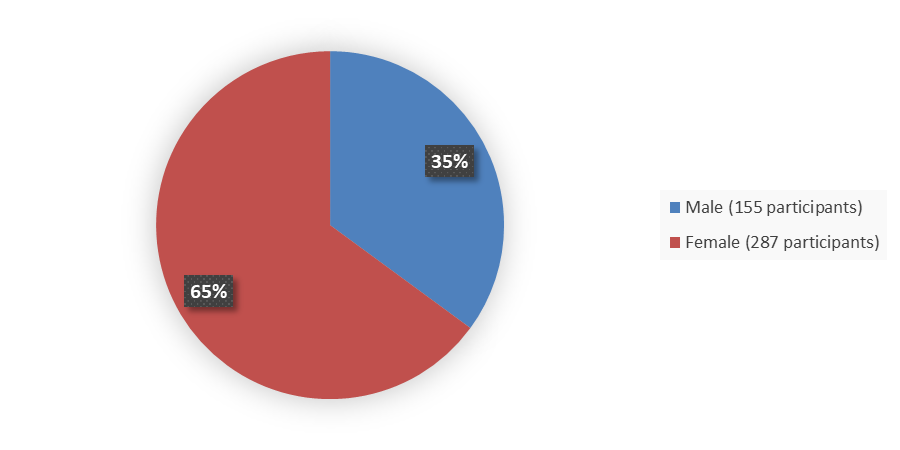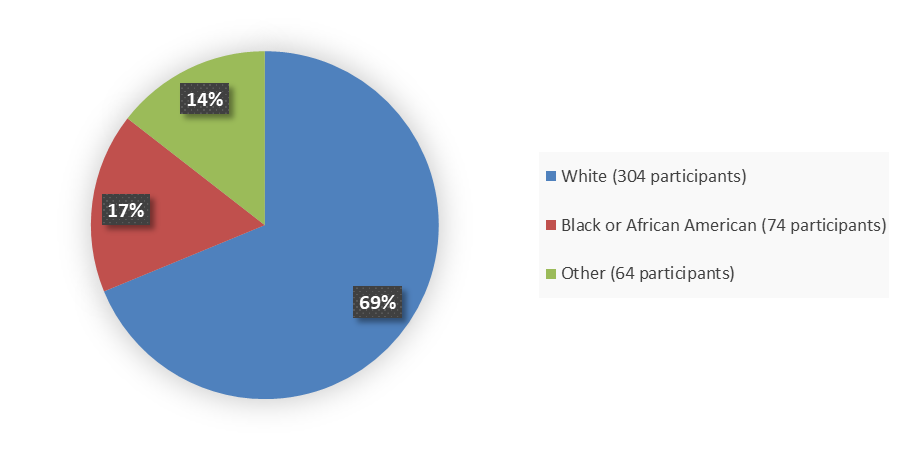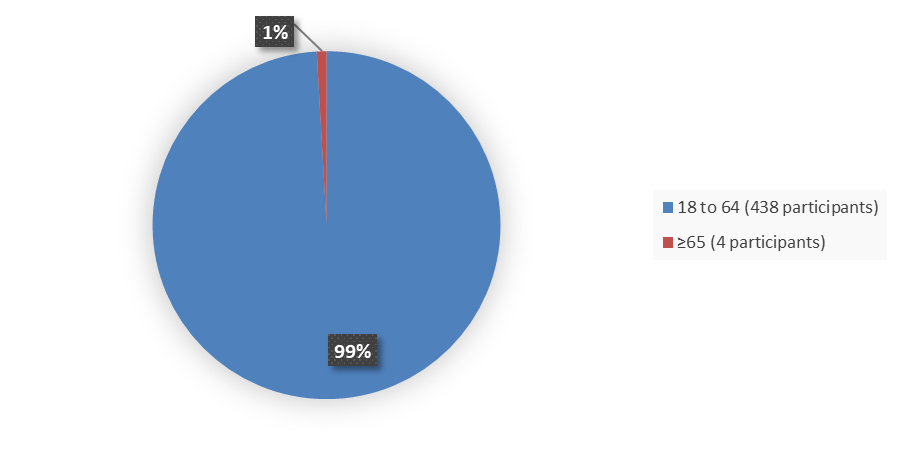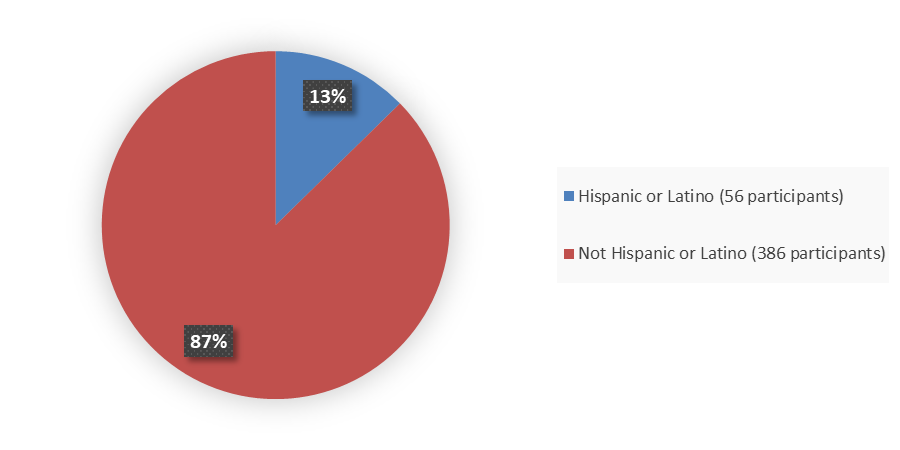Drug Trials Snapshots: EXXUA
HOW TO USE THIS SNAPSHOT
The information provided in Snapshots highlights who participated in the key clinical trials that supported the original FDA approval of this drug, and whether there were differences among sex, race, age, and ethnic groups. The “MORE INFO” bar shows more detailed, technical content for each section. The Snapshot is intended as one tool for consumers to use when discussing the risks and benefits of the drugs.
LIMITATIONS OF THIS SNAPSHOT:
Do not rely on Snapshots to make decisions regarding medical care. Always speak to your healthcare provider about the benefits and risks of a drug.
Some of the information in this Snapshot is for presentation purposes and does not represent the approved conditions of use of this drug. Refer to the EXXUA Prescribing Information for all of the approved conditions of use of this drug (e.g., indication(s), population(s), dosing regimen(s), safety information).
Snapshots are limited to the information available at the time of the original approval of the drug and do not provide information on who participated in clinical trials that supported later approvals for additional uses of the drug (if applicable).
EXXUA (gepirone)
EKS-shoo-uh
Fabre-Kramer Pharmaceuticals, Inc.
Original Approval date: September 22, 2023
DRUG TRIALS SNAPSHOT SUMMARY:
What is the drug for?
EXXUA is an antidepressant drug used for the treatment of major depressive disorder (MDD) in adults.
How is this drug used?
EXXUA is a tablet that is taken by mouth once a day.
Who participated in the clinical trials?
The FDA approved EXXUA based on evidence from two placebo-controlled, flexible-dose, clinical studies (Study 1 and Study 2) of 456 adult patients with MDD during an 8-week double-blind treatment period. The trials were conducted at 14 sites in the United States. Study 1 had a median age of 39 years and participants were 61% female, 73% White, 9% Black or African American, 2% Asian, and 16% Other (Hispanic or Native American). Study 2 had a median age of 39 years and participants were 69% female, 65% White, 23% Black or African American, 1% Asian, and 11% Hispanic.
The same two trials were used to assess the efficacy and safety of EXXUA. Safety findings are also available in over 1,600 patients from other placebo-controlled studies that compared EXXUA to other commonly used antidepressants. The number of patients representing efficacy findings may differ from the number of patients representing safety findings due to different pools of study participants analyzed for efficacy and safety.
How were the trials designed?
The efficacy of EXXUA was evaluated in two clinical trials of 442 patients (efficacy population) with MDD.
In Study 1, the benefit of EXXUA was evaluated in adults 18 to 69 years of age with MDD. A total of 209 patients were randomized in a 1:1 ratio to receive either EXXUA or placebo once a day for eight weeks. After an initial dosage of 18.2 mg once daily, the dosage was increased to 36.3 mg once daily on Day 4 of treatment. The dosage could then be increased to 54.5 mg once daily after Day 7, and to 72.6 mg once daily after an additional seven days. The overall improvement of Hamilton Depression Rating Scale (HAMD-17) total score observed at Week 8 of treatment was significantly greater in patients who received EXXUA compared with patients who received placebo.
In Study 2, the benefit of EXXUA was evaluated in adults 18 to 64 years of age with MDD. A total of 248 patients were randomized in a 1:1 ratio to receive either EXXUA or placebo once a day for eight weeks. After an initial dosage of 18.2 mg once daily, the dosage was increased to 36.3 mg once daily on Day 4 of treatment. The dosage could then be increased to 54.5 mg once daily after Day 7, and to 72.6 mg once daily after an additional seven days. The overall improvement of HAMD-17 total score observed at Week 8 of treatment was significantly greater in patients who received EXXUA compared with patients who received placebo.
The benefit of EXXUA was assessed in both trials by determining the improvement in depressive symptoms (the difference in HAMD-17 scores before and after treatment).
DEMOGRAPHICS SNAPSHOT
Figure 1 summarizes how many male and female patients were enrolled in the clinical trials used to evaluate the efficacy of EXXUA.
Figure 1. Baseline Demographics by Sex, Efficacy Population
Source: Adapted from FDA Review
Figure 2 summarizes the percentage of patients by race who were enrolled in the clinical trials used to evaluate the efficacy of EXXUA.
Figure 2. Baseline Demographics by Race, Efficacy Population
Source: Adapted from FDA Review
Figure 3 summarizes the percentage of patients by age who were enrolled in the clinical trials used to evaluate the efficacy of EXXUA.
Figure 3. Baseline Demographics by Age, Efficacy Population
Source: Adapted from FDA Review
Figure 4 summarizes the percentage of patients by ethnicity who were enrolled in the clinical trials used to evaluate the efficacy of EXXUA.
Figure 4. Baseline Demographics by Ethnicity, Efficacy Population
Source: Adapted from FDA Review
Who participated in the trials?
Table 1 summarizes demographic data for the pooled studies, based on the available efficacy data.
Table 1. Baseline Demographics of Efficacy Trials, Efficacy Population
| Demographic | Study 1 | Study 2 | Total |
|---|---|---|---|
| Sex | |||
| Female | 123 (60) | 164 (69) | 287 (65) |
| Male | 81 (40) | 74 (31) | 155 (35) |
| Race | |||
| White | 150 (74) | 154 (65) | 304 (69) |
| Black or African American | 19 (9) | 55 (23) | 74 (17) |
| Other | 35 (17) | 29 (12) | 64 (15) |
| Age group, years | |||
| <65 | 200 (98) | 238 (100) | 438 (99) |
| ≥65 | 4 (2) | 0 (0) | 4 (1) |
| Ethnicity | |||
| Hispanic or Latino | 29 (14) | 27 (11) | 56 (13) |
| Not Hispanic or Latino | 175 (86) | 211 (89) | 386 (87) |
Source: Adapted from FDA Review
What are the benefits of this drug?
EXXUA is a prescription medicine used to treat adults with a certain type of depression called MDD.
In two trials, patients with MDD who were given EXXUA achieved more improvement in depressive symptoms after eight weeks of treatment than patients given placebo.
What are the benefits of this drug (results of trials used to assess efficacy)?
The efficacy of EXXUA was evaluated in two 8-week, randomized, double-blind, placebo-controlled studies in adult patients (age 18 to 69 years) diagnosed with MDD. In both studies, EXXUA was started at a daily dose of 18.2 mg and, depending on response and tolerability, increased to 36.3 mg on Days 4 to 7, 54.5 mg after Day 7, and 72.6 mg after Day 14.
The primary measure of efficacy in each study was the change from baseline in the HAMD-17 total score at Week 8. In both studies, patients in the EXXUA groups experienced statistically significantly greater improvement on the primary endpoint compared to patients in the placebo groups (see Table 2).
Table 2. Results for the Primary Endpoint: Change From Baseline in the HAMD-17 Total Score at Week 8 in Adult Patients With MDD, Study 1 and Study 2
| Study | Treatment Group | N | Mean Baseline | LS Mean | Placebo-Subtracted |
|---|---|---|---|---|---|
| Study 1 | EXXUA (18.2 to 72.6 mg/day) | 101 | 22.7 (2.45) | -9.04 (0.78) | -2.47 (-4.41, -0.53) |
| Placebo | 103 | 22.8 (2.51) | 22.8 (2.51) | ||
| Study 2 | EXXUA (18.2 to 72.6 mg/day) | 116 | 23.9 (2.69) | -10.22 (0.75) | -2.45 (-4.47, -0.43) |
| Placebo | 122 | 24.2 (2.93) | -7.96 (0.73) |
Source: Adapted from FDA Review
In Study 1, the final dose of EXXUA was 72.6, 54.5, and 36.3 mg/day in 64%, 20%, and 17% of patients, respectively.
In Study 2, the final dose of EXXUA was 72.6, 54.5, 36.3, and 18.2 mg/day in 66%, 22%, 10%, and 2% of patients, respectively.
Abbreviations: CFB, change from baseline; CI, confidence interval; HAMD-17, Hamilton Depression Rating Scale; LS, least squares; MDD, major depressive disorder; SD, standard deviation; SE, standard error
What are the possible side effects?
The most common side effects of EXXUA are dizziness, nausea, insomnia, abdominal pain, and dyspepsia.
EXXUA may increase the risk of QT prolongation, a change in the electrical activity of your heart that can cause irregular heartbeats. Your doctor will check the electrical activity of your heart and your levels of body salts (electrolytes) before and during treatment with EXXUA, and also perform electrocardiograms.
EXXUA can raise serotonin levels if taken together with certain other antidepressants. Too much serotonin can cause signs and symptoms that can range from mild (shivering and diarrhea) to severe (muscle rigidity, fever, and seizures).
Manic episodes may happen in people with bipolar disorder who take EXXUA.
What are the possible side effects (results of trials used to assess safety)?
In Study 1 and Study 2, 7% (15/226) of patients treated with EXXUA and 3% (6/230) of patients receiving placebo discontinued treatment due to an adverse reaction. The most common reactions leading to discontinuation for patients taking EXXUA were dizziness and nausea. Table 3 presents the adverse reactions that occurred at an incidence of ≥2% of patients treated with EXXUA and at a higher incidence than in the placebo-treated patients in the two pooled efficacy trials. The safety population includes any patient who received at least one dose of trial drug.
The most common adverse reactions (≥5% and twice the incidence of placebo) in EXXUA-treated patients were dizziness, nausea, insomnia, abdominal pain, and dyspepsia.
The following is a list of adverse reactions that occurred at an incidence of <2% in patients with MDD treated with EXXUA and at least greater than placebo in Study 1 and Study 2: breast tenderness, confusional state, dyspnea, edema peripheral, energy increased, feeling abnormal, hypoesthesia, poor quality sleep, and thinking abnormal.
Additional adverse reaction observed in clinical studies of EXXUA were hypersensitivity reactions including rash, pruritus, and urticaria.
Table 3. Adverse Reactions That Occurred in ≥2% of Patients Treated With EXXUA and Greater Than the Incidence in Placebo-Treated Patients in Pooled MDD Studies (Study 1 and Study 2), Safety Population
| Adverse Reaction | EXXUA (18.2 mg to 76.2 mg) | Placebo |
|---|---|---|
| Dizziness1 | 49 | 10 |
| Nausea | 35 | 13 |
| Headache2 | 31 | 20 |
| Feeling sleepy or tired3 | 15 | 14 |
| Insomnia4 | 14 | 5 |
| Diarrhea | 10 | 9 |
| Upper respiratory tract infection | 8 | 7 |
| Dry mouth | 8 | 5 |
| Vomiting | 7 | 4 |
| Abdominal pain5 | 7 | 3 |
| Dyspepsia | 6 | 2 |
| Increased appetite | 5 | 3 |
| Constipation | 4 | 3 |
| Nasopharyngitis | 4 | 3 |
| Nasal congestion | 4 | 2 |
| Paresthesia | 4 | 1 |
| Hyperhidrosis | 4 | 0 |
| Palpitations | 4 | 0 |
| Weight increase | 3 | 1 |
| Agitation | 3 | 0 |
| Feeling jittery | 3 | 0 |
| Heart rate increased | 2 | 0 |
| Lethargy | 2 | 0 |
Source: Adapted from FDA Review
1 Dizziness includes lightheadedness, dizziness, and dizziness postural.
2 Headache includes headache, sinus headache, and tension headache.
3 Feeling sleepy or tired includes fatigue, sedation, and somnolence.
4 Insomnia includes initial insomnia, insomnia, middle insomnia, and terminal insomnia.
5 Abdominal pain includes abdominal discomfort, abdominal pain, and abdominal pain upper.
Were there any differences in how well the drug worked in clinical trials among sex, race and age?
- Sex: The occurrence of side effects was similar in males and females, but with a greater incidence of nausea in females and dizziness in males.
- Race: The occurrence of side effects was similar in White and Black or African American patients, but with sleep difficulties experienced more commonly with Black subjects compared to White subjects. The number of patients in other races was limited; therefore, differences in the occurrence of side effects among other races could not be determined.
- Age: The occurrence of side effects was similar in patients younger and older than 40 years of age, but with a higher incidence of dizziness and sleep difficulties in younger subjects compared to older subjects. The number of patients over 65 years was limited; therefore, differences in the occurrence of side effects among the elderly could not be determined.
- Ethnicity: There were differences in the occurrence of side effects for Hispanic and Non-Hispanic patients. However, the number of Hispanic patients was limited and therefore it is difficult to make meaningful comparisons between these two demographic groups.
Were there any differences in how well the drug worked in clinical trials among sex, race, and age groups?
Table 4 summarizes the occurrence of the most common adverse reactions by sex, race, age, and ethnicity in the safety population. Presented here are age groups younger and older than 40 years because the number of patients over 65 years old was limited.
Table 4. Adverse Reactions That Occurred in ≥2% of Patients Treated With EXXUA and Greater Than the Incidence in Placebo-Treated Patients in Pooled MDD Studies (Study 1 and Study 2) by Demographic Subgroup, Safety Population
| Adverse Event by Subgroup | EXXUA | Placebo | ||
|---|---|---|---|---|
| Sex | Males | Females | Males | Females |
| Dizziness1 | 42 (56.0) | 68 (45.0) | 8 (9.3) | 16 (11.1) |
| Nausea | 18 (24.0) | 62 (41.1) | 4 (4.7) | 27 (18.8) |
| Headache2 | 25 (33.3) | 46 (30.5) | 15 (17.4) | 31 (21.5) |
| Feeling sleepy or tired3 | 11 (14.7) | 24 (15.9) | 12 (14.0) | 21 (14.6) |
| Insomnia4 | 9 (12.0) | 22 (14.6) | 0 | 11 (7.6) |
| Diarrhea | 7 (9.3) | 15 (9.9) | 8 (9.3) | 12 (8.3) |
| Dry mouth | 6 (8.0) | 13 (8.6) | 3 (3.5) | 8 (5.6) |
| Upper respiratory tract infection | 2 (2.7) | 16 (10.6) | 4 (4.7) | 13 (9.0) |
| Abdominal pain5 | 4 (5.3) | 12 (7.9) | 1 (1.2) | 5 (3.5) |
| Vomiting | 3 (4.0) | 12 (7.9) | 1 (1.2) | 9 (6.3) |
| Race | Black N=39 n (%) | White N=152 n (%) | Black N=38 n (%) | White N=161 n (%) |
| Dizziness1 | 18 (46.2) | 74 (48.7) | 4 (10.5) | 19 (11.8) |
| Nausea | 15 (38.5) | 55 (36.2) | 3 (7.9) | 26 (16.1) |
| Headache2 | 12 (30.8) | 46 (30.3) | 5 (13.2) | 34 (21.1) |
| Feeling sleepy or tired3 | 12 (30.8) | 14 (9.2) | 6 (15.8) | 23 (14.3) |
| Insomnia4 | 1 (2.6) | 29 (19.1) | 1 (2.6) | 8 (5.0) |
| Diarrhea | 5 (12.8) | 16 (10.5) | 2 (5.3) | 16 (9.9) |
| Dry mouth | 5 (12.8) | 12 (7.9) | 3 (7.9) | 5 (3.1) |
| Upper respiratory tract infection | 3 (7.7) | 13 (8.6) | 3 (7.9) | 14 (8.7) |
| Abdominal pain5 | 3 (7.7) | 6 (3.9) | 1 (2.6) | 4 (2.5) |
| Vomiting | 1 (2.6) | 11 (7.2) | 3 (7.9) | 7 (4.3) |
| Age | <40 Years N=120 n (%) | ≥40 Years N=106 n (%) | <40 Years N=119 n (%) | ≥40 Years N=111 n (%) |
| Dizziness1 | 66 (55.0) | 44 (41.5) | 9 (7.6) | 15 (13.5) |
| Nausea | 46 (38.3) | 34 (32.1) | 16 (13.4) | 15 (13.5) |
| Headache2 | 39 (32.5) | 32 (30.2) | 26 (21.8) | 20 (18.0) |
| Feeling sleepy or tired3 | 24 (20.0) | 11 (10.4) | 17 (14.3) | 16 (14.4) |
| Insomnia4 | 14 (11.7) | 17 (16.0) | 7 (5.9) | 4 (3.6) |
| Diarrhea | 9 (7.5) | 13 (12.3) | 11 (9.2) | 9 (8.1) |
| Dry mouth | 11 (9.2) | 8 (7.5) | 7 (5.9) | 4 (3.6) |
| Upper respiratory tract infection | 8 (6.7) | 10 (9.4) | 13 (10.9) | 4 (3.6) |
| Abdominal pain5 | 11 (9.2) | 5 (4.7) | 5 (4.2) | 1 (0.9) |
| Vomiting | 12 (10.0) | 3 (2.8) | 5 (4.2) | 5 (4.5) |
| Ethnicity | Hispanic N=32 n (%) | Not Hispanic N=194 n (%) | Hispanic N=26 n (%) | Not Hispanic N=204 n (%) |
| Dizziness1 | 17 (53.1) | 93 (47.9) | 0 | 24 (11.8) |
| Nausea | 8 (25.0) | 72 (37.1) | 1 (3.8) | 30 (14.7) |
| Headache2 | 12 (37.5) | 59 (30.4) | 5 (19.2) | 41 (20.1) |
| Feeling sleepy or tired3 | 8 (25.0) | 27 (13.9) | 3 (11.5) | 30 (14.7) |
| Insomnia4 | 1 (3.1) | 30 (15.5) | 1 (3.8) | 10 (4.9) |
| Diarrhea | 1 (3.1) | 21 (10.8) | 1 (3.8) | 19 (9.3) |
| Dry mouth | 2 (6.3) | 17 (8.8) | 1 (3.8) | 10 (4.9) |
| Upper respiratory tract infection | 1 (3.1) | 17 (8.8) | 0 | 17 (8.3) |
| Abdominal pain5 | 6 (18.8) | 10 (5.2) | 1 (3.8) | 5 (2.5) |
| Vomiting | 2 (6.3) | 13 (6.7) | 0 | 10 (4.9) |
Source: Sponsor-generated table
Note: Table includes the ten most common adverse events in the EXXUA group. Percentage is calculated using the number in the subgroup column heading as the denominator.
1 Dizziness includes lightheadedness, dizziness, and dizziness postural.
2 Headache includes headache, sinus headache, and tension headache.
3 Feeling sleepy or tired includes fatigue, sedation, and somnolence.
4 Insomnia includes initial insomnia, insomnia, middle insomnia, and terminal insomnia.
5 Abdominal pain includes abdominal discomfort, abdominal pain, and abdominal pain upper.
GLOSSARY
CLINICAL TRIAL: Voluntary research studies conducted in people and designed to answer specific questions about the safety or effectiveness of drugs, vaccines, other therapies, or new ways of using existing treatments.
COMPARATOR: A previously available treatment or placebo that is compared to the actual drug being tested.
EFFICACY: How well the drug achieves the desired response when it is taken as described in a controlled clinical setting, such as during a clinical trial.
PLACEBO: An inactive substance or “sugar pill” that looks the same as, and is given the same way as, an active drug or treatment being tested. The effects of the active drug or treatment are compared to the effects of the placebo.
SUBGROUP: A subset of the population studied in a clinical trial. Demographic subsets include sex, race, and age groups.




